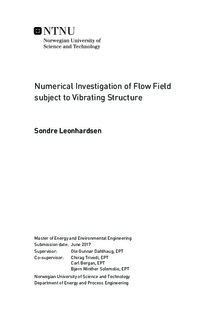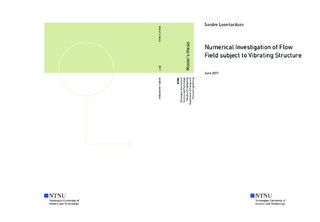| dc.description.abstract | Hydraulic turbines are more often than before running at off-design conditions. The flow conditions outside the best efficiency point may increase the mechanical load, and hence fatigue, on the turbine blades. The flow-induced vibration caused by Rotor-Stator-Interaction (RSI) is one of the main issues as the frequency of the pressure pulsations caused by RSI often lie close to the natural frequency of the turbine. The interaction between fluid and structure during transient operation, are yet to be fully understood. Credible estimation of the added mass effect, natural frequencies and hydrodynamic damping is the main challenge.
A hydrofoil test rig was developed to better understand the interaction between fluid flow and structure. Experimental measurements showed large vibration amplitudes during the lock-in condition. The lock-in condition was present at flow velocities around 11 m/s and a frequency of 623 Hz. Another problem experienced during the experimental measurements was that cavitation occurred at velocities higher than 25 m/s.
The first objective of this master thesis was to move the lock-in condition to a lower flow velocity. The lock-in condition is experienced to occur for low flow velocities in High-Head Francis Turbines. Numerical fluid flow and structure analyses were conducted to design a new hydrofoil where the objective is met. The available measurement data from the experiment was used as a reference for the numerical model. Different trailing edge (TE) profiles were tested to increase the vortex shedding frequency of the hydrofoil. By changing the TE and move the chamfer point of the hydrofoil 100 mm closer to the leading edge (LE), the expected new lock-in condition velocity is around 7.9 m/s. Also, the vortex shedding amplitude is expected to be reduced to a tenth of the amplitude of the original design.
The second objective of this thesis was to investigate and identify cavitation in the test rig. Low-pressure zones of the flow around the hydrofoil were identified at the top and bottom of the LE and at the chamfer point. The formation of water vapour was found to mainly originate from the top of the LE. The amount of water vapour in the test section varied periodically with similar frequency as found in experimental observations. The vortex shedding frequency of the hydrofoil was lowered as water vapour was included in the domain. | |

